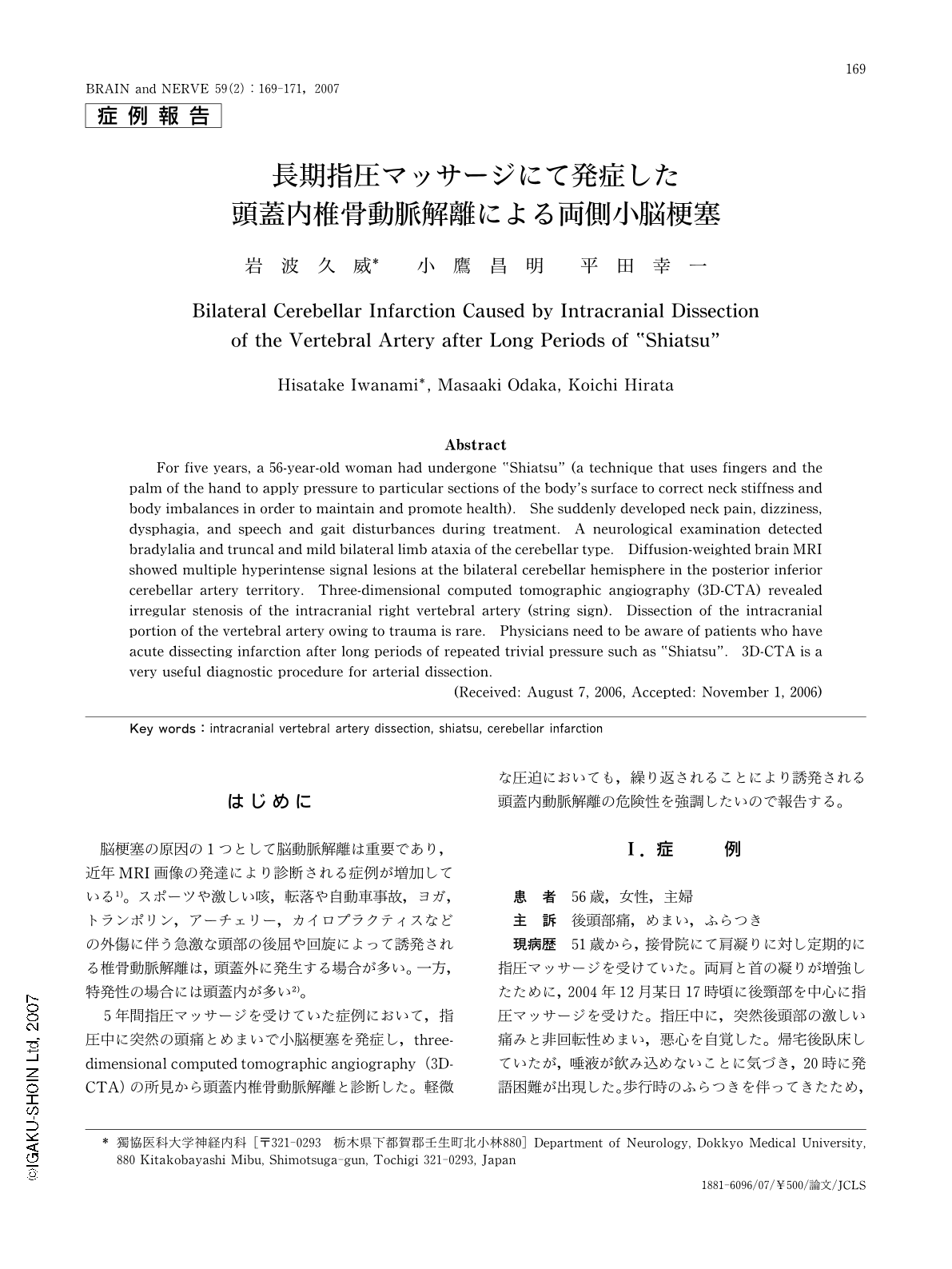21 0 0 0 長期指圧マッサージにて発症した頭蓋内椎骨動脈解離による両側小脳梗塞
はじめに 脳梗塞の原因の1つとして脳動脈解離は重要であり,近年MRI画像の発達により診断される症例が増加している1)。スポーツや激しい咳,転落や自動車事故,ヨガ,トランポリン,アーチェリー,カイロプラクティスなどの外傷に伴う急激な頭部の後屈や回旋によって誘発される椎骨動脈解離は,頭蓋外に発生する場合が多い。一方,特発性の場合には頭蓋内が多い2)。 5年間指圧マッサージを受けていた症例において,指圧中に突然の頭痛とめまいで小脳梗塞を発症し,three-dimensional computed tomographic angiography(3D-CTA)の所見から頭蓋内椎骨動脈解離と診断した。軽微な圧迫においても,繰り返されることにより誘発される頭蓋内動脈解離の危険性を強調したいので報告する。
2 0 0 0 IR 心身症と診断されていたTolosa-Hunt 症候群の15 歳女子
- 著者
- 渡部 弥栄子 今高 城治 斎藤 祥子 岩波 久威 鈴木 紫布 金谷 英明 桑島 成子 有阪 治 Yaeko Watabe George Imataka Shoko Saito Hisatake Iwanami Shiho Suzuki Hideaki Kanaya Shigeko Kuwashima Osamu Arisaka 獨協医科大学医学部 小児科学 獨協医科大学医学部 小児科学 獨協医科大学医学部 小児科学 獨協医科大学医学部 内科学(神経) 獨協医科大学医学部 内科学(神経) 獨協医科大学医学部 脳神経外科 獨協医科大学医学部 放射線科 獨協医科大学医学部 小児科学 Departments Of Pediatrics Dokkyo Medical University School Of Medicine Departments Of Pediatrics Dokkyo Medical University School Of Medicine Departments Of Pediatrics Dokkyo Medical University School Of Medicine Neurology Dokkyo Medical University School Of Medicine Neurology Dokkyo Medical University School Of Medicine Neurosurgery Dokkyo Medical University School Of Medicine Radiology Dokkyo Medical University School Of Medicine Departments Of Pediatrics Dokkyo Medical University School Of Medicine
- 雑誌
- Dokkyo journal of medical sciences (ISSN:03855023)
- 巻号頁・発行日
- vol.41, no.2, pp.177-181, 2014-07-25
Tolosa-Hunt症候群(THS)は先行する片側眼窩部痛と眼球運動障害を生じ,病態は海綿静脈洞の非特異的炎症性肉芽腫病変と推測されている.発症は年間100万人あたり1人前後で,40歳台の成人に多く小児例は稀である.今回,1カ月続く右眼をえぐられる様な頭痛を主訴とした15歳のTHSを報告する.発症後,各種頭痛薬で改善がなく,各種検査を施行し異常がないため心身症に伴う反復する片頭痛と診断された.当院で脳MRIを施行し右内頸動脈の狭窄を認めTHSと確定診断した.プレドニゾロン(PSL)1?mg/kg/dayを朝1回開始し,翌日頭痛は改善した.以降,半年かけてPSLを漸減し再発はない.Tolosa-Hunt syndrome(THS)is characterized by periorbital pain accompanying opthalmoplegia. The pathogenesis is considered to involve non-specific granulomatous inflammation in the cavernous sinus, and the frequency is around one case per year per million people. Symptoms usually develop in adulthood, and pediatric cases are rare. We report herein a case of THS in a 15-year-old girl whose headache was diagnosed as psychosomatic disease in the early stage of the clinical course. Her chief compliant was headache with strong pain in the right eye, continuing for 1 month. Although several medications were trialed to alleviate headaches, no improvement was achieved. Various physical examinations proved uninformative. Headache was therefore tentatively diagnosed as psychosomatic disease associated with migraine. Brain magnetic resonance imaging in our university hospital revealed strangulation of the internal carotid artery, and headache was diagnosed as confirmed THS. Oral administration of prednisolone was started at 1 mg/kg/day, given once in the morning. Headache improved from the next day. Oral therapy with prednisolone was tapered over the course of 6 months and headache did not recur.
- 著者
- 岩波 久威 小鷹 昌明 平田 幸一
- 出版者
- 医学書院
- 雑誌
- Brain and nerve (ISSN:18816096)
- 巻号頁・発行日
- vol.59, no.2, pp.169-171, 2007-02
